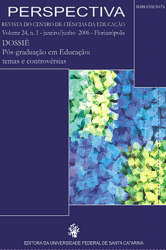The creation of the Santa Catarina Children’s Museum: an experience in progress
DOI:
https://doi.org/10.5007/%25xAbstract
The purpose of this article is to present in general terms the history, evolution,plan and current phase of the Santa Catarina Children’s Museum.The museum project was inspired by the Children’s Museum of Manhattan, the Brooklyn Children’s Museum, the Cité des Enfants de Paris, the Museu daCriança de Lisboa and by the pedagogical activities realized with children at the Louvre, George Pompidou and D’Orsay museums in Paris. Familiar with the cultural diversity of Santa Catarina children through a study conducted since 1999, involving children of various ethnicities, in various municipalities of the state, the researcher sought the inclusion of “different” children in activities of the cultural space to be created. The project uses the perspective of cultural hybridization suggested by Nestor Canclini. Conceived to attend children from 3 – 14 years of age, the museum will have an interactive character and its mission is to emphasize the participation of children in the culture of their ancestors, opening doors to others and conjugating them with current cultural expressions. It proposes the creation of the Children’s Imagination Network, to be established among children of different unicipalities, states and countries; to stimulate creativity and cultural production and inclusionary aesthetics, through traditional resources and new technologies.Partnerships are being studied with the Sapiens Park development project, the focus of which is Human Development and with the municipal government of Pomerode, where the installation of a prototype of the Santa CatarinaChildren’s Museum is planned.
Downloads
Published
How to Cite
Issue
Section
License
This journal provides open access to all of it content on the principle that making research freely available to the public supports a greater global exchange of knowledge. Such access is associated with increased readership and increased citation of an author's work. For more information on this approach, see the Public Knowledge Project, which has designed this system to improve the scholarly and public quality of research, and which freely distributes the journal system as well as other software to support the open access publishing of scholarly resources. The names and email addresses entered in this journal site will be used exclusively for the stated purposes of this journal and will not be made available for any other purpose or to any other party.
The Perspectiva allow the author(s) yo hold the copyright without restrictions as well as publishing rights. If the paper will be republished later in another format, the author(s) should inform that it has originally been published as article in Perspectiva Journal and quote the complete references.



